Mechanisms of the Action of Fire-Retardants on Reducing the Flammability of Certain Classes of Polymers and Glass-Reinforced Plastics Based on the Study of Their Combustion
Abstract
1. Introduction
2. The Experimental Methods for Studying the Combustion Characteristics, Thermal Decomposition, and the Flame Structure of Polymers without Flame-Retardant Additives and with Flame-Retardant Additives
2.1. PMMA
2.1.1. Investigation of Flame Structure Using Probe Methods
2.1.2. A Method for Measuring the Fluorescence of the OH Radical in a Flame Spreading over PMMA and PMMA-TPP Using Planar Laser-Induced Fluorescence (PLIF)
2.2. PE
2.2.1. The Dynamic Mass Spectrometric Thermal Analysis Method
2.2.2. Measurement of the Diffusion Flame Structure of UHMWPE and PE in Air in the “Candle” Mode
2.2.3. Measuring the Structure of a Diffusion Flame of UHMWPE in Counterflow with Air
2.3. Glass Fiber-Reinforced Epoxy Resin
2.4. Flammability Tests, TGA, Elemental Analysis
3. Approaches Developing Numerical Models of Flame Propagation over Solid Combustible Materials with and without Flame-Retardant Additives
3.1. Formulation
3.2. Numerical Method
4. Combustion Mechanisms of PMMA, PE, and GFRER without Flame-Retardant Additives and with Flame-Retardant Additives
4.1. The Gas-Phase Mechanism of Action of TPP on Flame Propagation over PMMA
4.2. The Mechanism of Action of TPP on the Thermal Decomposition and Combustion of PE
4.2.1. The Effect of TPP Addition to UHMWPE and HDPE on the Burning Rate and LOI
4.2.2. Inhibition of UHMWPE and HDPE Pyrolysis in an Inert Medium
4.2.3. The Effect of TPP Addition on the Thermal and Chemical Structure of a Polyethylene Diffusion Flame in the “Candle” Mode
Temperature Profiles
Species Concentration Profiles
4.2.4. The Effect of TPP Addition on the Thermal and Chemical Structure of Polyethylene–Air Counterflow Flame
Temperature Profiles
Species Concentration Profiles
4.3. The Mechanism of Action of DOPO and Graphene on Flame Propagation over Glass-Fiber-Reinforced Epoxy Resin
5. Conclusions
Author Contributions
Funding
Institutional Review Board Statement
Acknowledgments
Conflicts of Interest
Abbreviations
| AHP | aluminum hypophosphite |
| AlPi | aluminum diethylphosphinate |
| APP | ammonium polyphosphate |
| ATH | aluminum hydroxide |
| CF | carbon fiber |
| DDM-DOPO | 4,4′-diamino-diphenylmethane 9,10-dihydro-9-oxa-10-phosphaphenanthrene-10-oxide |
| DMSTA | dynamic mass spectrometric thermal analysis |
| DOPI | heterocyclic 9,10-dihydro-9-oxy-10-phosphaphenanthrene-10-oxide tris-[(acryloyloxy)ethyl] isocyanurate |
| DOPO | 9,10-dehydro,9-oxa,10-phosphophenanthrene,10-oxide |
| DOPP | 9,10-dihydro-9-oxy-10-phosphaphenanthrene-10-oxide tetra-[(acryloyloxy)ethyl] pentarythrit |
| DSC | differential scanning calorimetry |
| DTG | differential thermogravimetric analysis |
| EG | expandable graphite |
| FR | fire-retardant |
| FTIR | Fourier transform infrared spectroscopy |
| GFRER | glass fiber reinforced epoxy resin |
| HDPE | high density polyethylene |
| HRR | heat release rate |
| IR | infrared |
| LDPE | low-density polyethylene |
| LOI | limiting oxygen index |
| MMA | methyl methacrylate |
| MRP | microencapsulated red phosphorus |
| PE | polyethylene |
| PLIF | planar laser-induced fluorescence |
| PMMA | polymethylmethacrylate |
| ROS | rate of flame spread |
| RP | red phosphorus |
| TD | triazine derivative |
| TGA | thermogravimetric analysis |
| TPP | triphenyl phosphate |
| UHMWPE | ultra-high-molecular-weight polyethylene |
| UL-94 | standard for safety of flammability of plastic |
| VBB | vertical Bunsen burner test |
Nomenclature
| C | specific heat capacity [J/kg/K] |
| diffusion coefficient [m2/s] | |
| activation energy [J/mol] | |
| gravity acceleration [m/s2] | |
| preexponential factor [s−1] | |
| molar mass [g/mol] | |
| mass burning rate [g/s] | |
| pyrolysis reaction order [-] | |
| pressure [Pa] | |
| heat release [J/kg] | |
| heat flux [W/m2] | |
| universal gas constant [J/mol/K] | |
| temperature [K] | |
| time [s] | |
| velocity [m/s] | |
| reaction rate [s−1] | |
| coordinate along fuel surface [m] | |
| gas component mass fraction [-] | |
| coordinate normal to fuel surface [m] | |
| Greek symbols | |
| conversion degree [-] | |
| solid component mass fraction [-] | |
| burnout degree [-] | |
| solid component volume fraction [-] | |
| thermal conductivity [W/m/K] | |
| dynamic molecular viscosity [kg/m/s] | |
| stoichiometric coefficient [-] | |
| density [kg/m3] | |
| half-thickness [m] | |
| inhibition effect coefficient | |
| Subscripts | |
| ambient | |
| binder | |
| fuel | |
| F | fiber |
| gas | |
| inert component | |
| oxidizer | |
| product | |
| pyrolysis | |
| solid | |
| Superscripts | |
| radiative | |
| along fuel surface | |
| normal to fuel surface | |
References
- Sener, A.A.; Demirhan, E. The Investigation of Using Magnesium Hydroxide as a Flame Retardant in the Cable Insulation Material by Cross-Linked Polyethylene. Mater. Des. 2008, 29, 1376–1379. [Google Scholar] [CrossRef]
- Gong, T.; Xie, Q.; Huang, X. Fire Behaviors of Flame-Retardant Cables Part I: Decomposition, Swelling and Spontaneous Ignition. Fire Saf. J. 2018, 95, 113–121. [Google Scholar] [CrossRef]
- Xie, Q.; Gong, T.; Huang, X. Fire Zone Diagram of Flame-Retardant Cables: Ignition and Upward Flame Spread. Fire Technol. 2021, 57, 2643–2659. [Google Scholar] [CrossRef]
- Yan, W.; Shen, Y.; An, W.; Jiang, L.; Zhou, Y.; Sun, J. Experimental Study on the Width and Pressure Effect on the Horizontal Flame Spread of Insulation Material. Int. J. Therm. Sci. 2017, 114, 114–122. [Google Scholar] [CrossRef]
- Zhu, H.; Xu, S. Synthesis and Properties of Rigid Polyurethane Foams Synthesized from Modified Urea-Formaldehyde Resin. Constr. Build. Mater. 2019, 202, 718–726. [Google Scholar] [CrossRef]
- Zhang, W.; Jia, J.; Zhang, J.; Ding, Y.; Zhang, J.; Lu, K.; Mao, S. Pyrolysis and Combustion Characteristics of Typical Waste Thermal Insulation Materials. Sci. Total Environ. 2022, 834, 155484. [Google Scholar] [CrossRef] [PubMed]
- Xie, Q.; Chen, H.; Yang, Y.; Ding, Y.; Yuan, Y. Thermal Kinetic Parameter Analysis by Series of Thermogravimetry Experiments with Varied Sample Mass for Scale-up Applications. J. Therm. Anal. 2022, 147, 9737–9746. [Google Scholar] [CrossRef]
- Zhou, Y.; Bu, R.; Gong, J.; Yan, W.; Fan, C. Experimental Investigation on Downward Flame Spread over Rigid Polyurethane and Extruded Polystyrene Foams. Exp. Therm. Fluid Sci. 2018, 92, 346–352. [Google Scholar] [CrossRef]
- Wang, D.-Y. Novel Fire Retardant Polymers and Composite Materials; Woodhead Publishing: Sawston, UK, 2016; ISBN 978-0-08-100163-9. [Google Scholar]
- Huang, X.; Wang, C.; Gao, J.; Zhou, Z.; Tang, G.; Wang, C. Research on Two Sides Horizontal Flame Spread over Rigid Polyurethane with Different Flame Retardants. J. Therm. Anal. 2021, 146, 2141–2150. [Google Scholar] [CrossRef]
- Luo, S.; Xie, Q.; Tang, X.; Qiu, R.; Yang, Y. A Quantitative Model and the Experimental Evaluation of the Liquid Fuel Layer for the Downward Flame Spread of XPS Foam. J. Hazard. Mater. 2017, 329, 30–37. [Google Scholar] [CrossRef]
- Luo, S.; Xie, Q.; Qiu, R. Melting and Dripping Flow Behaviors on the Downward Flame Spread of a Wide XPS Foam. Fire Technol. 2019, 55, 2055–2086. [Google Scholar] [CrossRef]
- Luo, S.; Xie, Q.; Da, L.; Qiu, R. Experimental Study on Thermal Structure inside Flame Front with a Melting Layer for Downward Flame Spread of XPS Foam. J. Hazard. Mater. 2019, 379, 120775. [Google Scholar] [CrossRef] [PubMed]
- Xu, B.; Wu, X.; Qian, L.; Qiu, Y.; Tang, S.; Xi, W.; Fang, Y. Intumescent Flame-Retardant Poly(1, 4-Butylene Terephthalate) with Ammonium Polyphosphate and a Hyperbranched Triazine Charring-Foaming Agent: Flame Retardancy Performance and Mechanisms. J. Fire Sci. 2017, 35, 317–340. [Google Scholar] [CrossRef]
- Özmen, F.K.; Üreyen, M.E.; Koparal, A.S. Cleaner Production of Flame-Retardant-Glass Reinforced Epoxy Resin Composite for Aviation and Reducing Smoke Toxicity. J. Clean. Prod. 2020, 276, 124065. [Google Scholar] [CrossRef]
- Biswas, B.; Kandola, B. The Effect of Chemically Reactive Type Flame Retardant Additives on Flammability of PES Toughened Epoxy Resin and Carbon Fibre-Reinforced Composites. Polym. Adv. Technol. 2011, 22, 1192. [Google Scholar] [CrossRef]
- Leventon, I.T.; Stoliarov, S.I.; Kraemer, R.H. The Impact of Bromine- and Phosphorous-Based Flame Retardants on Flame Stability and Heat Feedback from Laminar Wall Flames. Fire Saf. J. 2019, 109, 102819. [Google Scholar] [CrossRef]
- Ma, C.; Wang, J.; Yuan, Y.; Mu, X.; Pan, Y.; Song, L.; Hu, Y. An Insight into Gas Phase Flame Retardant Mechanisms of AHP versus AlPi in PBT: Online Pyrolysis Vacuum Ultraviolet Photoionization Time-of-Flight Mass Spectrometry. Combust. Flame 2019, 209, 467–477. [Google Scholar] [CrossRef]
- Geschwindner, C.; Goedderz, D.; Li, T.; Köser, J.; Fasel, C.; Riedel, R.; Altstädt, V.; Bethke, C.; Puchtler, F.; Breu, J.; et al. Investigation of Flame Retarded Polypropylene by High-Speed Planar Laser-Induced Fluorescence of OH Radicals Combined with a Thermal Decomposition Analysis. Exp. Fluids 2020, 61, 30. [Google Scholar] [CrossRef]
- Friederich, B.; Laachachi, A.; Ferriol, M.; Ruch, D.; Cochez, M.; Toniazzo, V. Improvement of Thermal Stability and Fire Behaviour of Pmma by a (Metal Oxide Nanoparticles/Ammonium Polyphosphate/ Melamine Polyphosphate) Ternary System. In Integrated Systems, Design and Technology 2010; Fathi, M., Holland, A., Ansari, F., Weber, C., Eds.; Springer: Berlin/Heidelberg, Germany, 2011; pp. 47–58. [Google Scholar]
- Jang, B.N.; Wilkie, C.A. The Effects of Triphenylphosphate and Recorcinolbis(Diphenylphosphate) on the Thermal Degradation of Polycarbonate in Air. Thermochim. Acta 2005, 433, 1–12. [Google Scholar] [CrossRef]
- Schartel, B.; Braun, U.; Balabanovich, A.I.; Artner, J.; Ciesielski, M.; Döring, M.; Perez, R.M.; Sandler, J.K.W.; Altstädt, V. Pyrolysis and Fire Behaviour of Epoxy Systems Containing a Novel 9,10-Dihydro-9-Oxa-10-Phosphaphenanthrene-10-Oxide-(DOPO)-Based Diamino Hardener. Eur. Polym. J. 2008, 44, 704–715. [Google Scholar] [CrossRef]
- Krala, G.; Ubowska, A.; Kowalczyk, K. Mechanical and Thermal Analysis of Injection Molded Poly(Methyl Methacrylate) Modified with 9,10-dihydro-9-oxa-10-phosphaphenanthrene-10-oxide (DOPO) Fire Retarder. Polym. Eng. Sci. 2014, 54, 1030–1037. [Google Scholar] [CrossRef]
- Tsai, T.-Y.; Lin, M.-J.; Chang, C.-W.; Li, C.-C. Morphology and Properties of Poly(Methyl Methacrylate)/Clay Nanocomposites by in-Situ Solution Polymerization. J. Phys. Chem. Solids 2010, 71, 590–594. [Google Scholar] [CrossRef]
- Kim, S.; Wilkie, C.A. Transparent and Flame Retardant PMMA Nanocomposites. Polym. Adv. Technol. 2008, 19, 496–506. [Google Scholar] [CrossRef]
- Tsai, T.-Y.; Lin, M.-J.; Chuang, Y.-C.; Chou, P.-C. Effects of Modified Clay on the Morphology and Thermal Stability of PMMA/Clay Nanocomposites. Mater. Chem. Phys. 2013, 138, 230–237. [Google Scholar] [CrossRef]
- Tsai, T.-Y.; Bunekar, N.; Liang, S.-W. Effect of Multiorganomodified LiAl- or MgAl-Layered Double Hydroxide on the PMMA Nanocomposites. Adv. Polym. Technol. 2018, 37, 31–37. [Google Scholar] [CrossRef]
- Jiang, S.; Chen, G.; Hu, Y.; Gui, Z.; Hu, Z. A New Strategy for Simultaneously Improved Flame Retardancy, Thermal Properties, and Scratch Resistance of Transparent Poly(Methyl Methacrylate). Ind. Eng. Chem. Res. 2015, 54, 4737–4747. [Google Scholar] [CrossRef]
- Xie, W.; Wang, B.; Liu, Y.; Wang, Q.; Yang, Z. Flame Retardancy of a Novel High Transparent Poly(Methyl Methacrylate) Modified with Phosphorus-Containing Compound. React. Funct. Polym. 2020, 153, 104631. [Google Scholar] [CrossRef]
- Bakhtina, G.D.; Kochnov, A.B.; Borisov, S.V.; Novakov, I.A. Properties of copolymers of methyl methacrylate with phosphorus-chlorine-silicon-containing methacrylates. Plast. Masses 2018, 3–6. [Google Scholar] [CrossRef]
- Cinausero, N.; Azema, N.; Lopez-Cuesta, J.-M.; Cochez, M.; Ferriol, M. Synergistic Effect between Hydrophobic Oxide Nanoparticles and Ammonium Polyphosphate on Fire Properties of Poly(Methyl Methacrylate) and Polystyrene. Polym. Degrad. Stab. 2011, 96, 1445–1454. [Google Scholar] [CrossRef]
- Peters, E.N. Flame-Retardant Thermoplastics. I. Polyethylene–Red Phosphorus. J. Appl. Polym. Sci. 1979, 24, 1457–1464. [Google Scholar] [CrossRef]
- Xu, Z.; Yan, L.; Chen, L. Synergistic Flame Retardant Effects between Aluminum Hydroxide and Halogen-Free Flame Retardants in High Density Polyethylene Composites. Procedia Eng. 2016, 135, 631–636. [Google Scholar] [CrossRef]
- Li, J.; Wang, H.; Li, Z.H.; Zhao, T.T.; Wang, T.T.; Wang, R.N.; Cao, B.W.; Zhang, X.L.; Zheng, W.; Li, L.B. Study on Thermal Degradation and Kinetic of Microencapsulated Red Phosphorus (MRP)/High Density Polyethylene (HDPE) Composite. Key Eng. Mater. 2020, 842, 98–104. [Google Scholar] [CrossRef]
- Wang, D.K.; He, H.; Yu, P. Flame-Retardant and Thermal Degradation Mechanism of Low-Density Polyethylene Modified with Aluminum Hypophosphite and Microencapsulated Red Phosphorus. J. Appl. Polym. Sci. 2016, 133. [Google Scholar] [CrossRef]
- Thi, N.H.; Nguyen, T.N.; Oanh, H.T.; Trang, N.T.T.; Tham, D.Q.; Nguyen, H.T.; Van Nguyen, T.; Hoang, M.H. Synergistic Effects of Aluminum Hydroxide, Red Phosphorus, and Expandable Graphite on the Flame Retardancy and Thermal Stability of Polyethylene. J. Appl. Polym. Sci. 2021, 138, 50317. [Google Scholar] [CrossRef]
- Shin, B.-S.; Jung, S.-T.; Jeun, J.; Kim, H.-B.; Oh, S.-H.; Kang, P.-H. A Study on Flammability and Mechanical Properties of HDPE/EPDM/Boron Carbide/Triphenyl Phosphate Blends with Compatibilizer. Polym. Korea 2012, 36, 549–554. [Google Scholar] [CrossRef][Green Version]
- Wang, H.; Cao, J.; Cao, C.; Guo, Y.; Luo, F.; Qian, Q.; Huang, B.; Xiao, L.; Chen, Q. Influence of Phosphorus-Grafted Expandable Graphite on the Flame-Retardant Property of UHMWPE Composite. Polym. Adv. Technol. 2019, 30, 493–503. [Google Scholar] [CrossRef]
- Luyt, A.S.; Malik, S.S.; Gasmi, S.A.; Porfyris, A.; Andronopoulou, A.; Korres, D.; Vouyiouka, S.; Grosshauser, M.; Pfaendner, R.; Brüll, R.; et al. Halogen-Free Flame-Retardant Compounds. Thermal Decomposition and Flammability Behavior for Alternative Polyethylene Grades. Polymers 2019, 11, 1479. [Google Scholar] [CrossRef]
- Lau, S.; Atakan, B. Isothermal Pyrolysis Investigation of Aluminum Diethylphosphinate Mixed as a Flame Retardant Additive into Ultra-High Molecular Weight Polyethylene. Combust. Flame 2020, 222, 272–284. [Google Scholar] [CrossRef]
- Lau, S.; Gonchikzhapov, M.; Paletsky, A.; Shmakov, A.; Korobeinichev, O.; Kasper, T.; Atakan, B. Aluminum Diethylphosphinate as a Flame Retardant for Polyethylene: Investigation of the Pyrolysis and Combustion Behavior of PE/AlPi-Mixtures. Combust. Flame 2022, 240, 112006. [Google Scholar] [CrossRef]
- Cordeiro, I.M.D.C.; Chen, T.B.Y.; Yuen, A.C.Y.; Wang, C.; Chan, Q.N.; Zhang, J.; Yeoh, G.H. Pyrolysis and Combustion Characterisation of HDPE/APP Composites via Molecular Dynamics and CFD Simulations. J. Anal. Appl. Pyrolysis 2022, 163, 105499. [Google Scholar] [CrossRef]
- Berardi, U.; Meacham, B.J.; Dembsey, N.A.; You, Y.-G. Fire Performance Assessment of a Fiber Reinforced Polymer Wall Panel Used in a Single Family Dwelling. Fire Technol. 2014, 50, 1607–1617. [Google Scholar] [CrossRef]
- Eibl, S. Potential for the Formation of Respirable Fibers in Carbon Fiber Reinforced Plastic Materials after Combustion. Fire Mater. 2017, 41, 808–816. [Google Scholar] [CrossRef]
- Kandare, E.; Kandola, B.K.; McCarthy, E.D.; Myler, P.; Edwards, G.; Jifeng, Y.; Wang, Y.C. Fiber-Reinforced Epoxy Composites Exposed to High Temperature Environments. Part II: Modeling Mechanical Property Degradation. J. Compos. Mater. 2010, 45, 1511–1521. [Google Scholar] [CrossRef]
- Bachtiar, E.V.; Kurkowiak, K.; Yan, L.; Kasal, B.; Kolb, T. Thermal Stability, Fire Performance, and Mechanical Properties of Natural Fibre Fabric-Reinforced Polymer Composites with Different Fire Retardants. Polymers 2019, 11, 699. [Google Scholar] [CrossRef]
- Guo, W.; Zhao, Y.; Wang, X.; Cai, W.; Wang, J.; Song, L.; Hu, Y. Multifunctional Epoxy Composites with Highly Flame Retardant and Effective Electromagnetic Interference Shielding Performances. Compos. Part B Eng. 2020, 192, 107990. [Google Scholar] [CrossRef]
- Perret, B.; Schartel, B.; Stöß, K.; Ciesielski, M.; Diederichs, J.; Döring, M.; Krämer, J.; Altstädt, V. Novel DOPO-Based Flame Retardants in High-Performance Carbon Fibre Epoxy Composites for Aviation. Eur. Polym. J. 2011, 47, 1081–1089. [Google Scholar] [CrossRef]
- Trubachev, S.A.; Korobeinichev, O.P.; Karpov, A.I.; Shaklein, A.A.; Glaznev, R.K.; Gonchikzhapov, M.B.; Paletsky, A.A.; Tereshchenko, A.G.; Shmakov, A.G.; Bespalova, A.S.; et al. The Effect of Triphenyl Phosphate Inhibition on Flame Propagation over Cast PMMA Slabs. Proc. Combust. Inst. 2021, 38, 4635–4644. [Google Scholar] [CrossRef]
- Korobeinichev, O.P.; Trubachev, S.A.; Joshi, A.K.; Kumar, A.; Paletsky, A.A.; Tereshchenko, A.G.; Shmakov, A.G.; Glaznev, R.K.; Raghavan, V.; Mebel, A.M. Experimental and Numerical Studies of Downward Flame Spread over PMMA with and without Addition of Tri Phenyl Phosphate. Proc. Combust. Inst. 2021, 38, 4867–4875. [Google Scholar] [CrossRef]
- Ranga, H.R.; Korobeinichev, O.P.; Harish, A.; Raghavan, V.; Kumar, A.; Gerasimov, I.E.; Gonchikzhapov, M.B.; Tereshchenko, A.G.; Trubachev, S.A.; Shmakov, A.G. Investigation of the Structure and Spread Rate of Flames over PMMA Slabs. Appl. Therm. Eng. 2018, 130, 477–491. [Google Scholar] [CrossRef]
- Korobeinichev, O.; Gonchikzhapov, M.; Tereshchenko, A.; Gerasimov, I.; Shmakov, A.; Paletsky, A.; Karpov, A. An Experimental Study of Horizontal Flame Spread over PMMA Surface in Still Air. Combust. Flame 2018, 188, 388–398. [Google Scholar] [CrossRef]
- Warnatz, J.; Maas, U.; Dibble, R.W. Combustion: Physical and Chemical Fundamentals, Modeling and Simulation, Experiments, Pollutant Formation, 4th ed.; Springer: Berlin/Heidelberg, Germany, 2006; ISBN 978-3-540-25992-3. [Google Scholar]
- Mcbride, B.J.G. Coefficients for Calculating Thermodynamic and Transport Properties of Individual Species; National Aeronautics and Space Administration, Office of Management, Scientific and Technical Information Program: Washington, DC, USA, 1993.
- Paletsky, A.A.; Korobeinichev, O.P.; Tereshchenko, A.G.; Volkov, E.N.; Polyakov, P.D. Flame Structure of HMX/GAP Propellant at High Pressure. Proc. Combust. Inst. 2005, 30, 2105–2112. [Google Scholar] [CrossRef]
- Trubachev, S.A.; Korobeinichev, O.P.; Kostritsa, S.A.; Kobtsev, V.D.; Paletsky, A.A.; Kumar, A.; Smirnov, V.V. An Insight into the Gas-Phase Inhibition Mechanism of Polymers by Addition of Triphenyl Phosphate Flame Retardant. AIP Conf. Proc. 2020, 2304, 020019. [Google Scholar] [CrossRef]
- Eckbreth, A.C. Laser Diagnostics for Combustion Temperature and Species, 2nd ed.; Gordon and Breach Publishers: Amsterdam, The Netherlands, 1996; ISBN 2884492259. [Google Scholar]
- Korobeinichev, O.P.; Shmelev, A.S.; Voronov, V.G.; Anisiforov, G.I. Application of Dynamic Mass Spectrometry and Computers for Kinetic Study. Construction of a Kinetic Model and Determination of Kinetic Constants in Thermal Decomposition Reactions. Therm. Anal. Heyden Lond. 1975, 1, 77–83. [Google Scholar]
- Korobeinichev, O.P.; Kuibida, L.V.; Paletsky, A.A.; Shmakov, A.G. Molecular-Beam Mass-Spectrometry to Ammonium Dinitramide Combustion Chemistry Studies. J. Propuls. Power 1998, 14, 991–1000. [Google Scholar] [CrossRef]
- Korobeinichev, O.P.; Paletsky, A.A.; Kuibida, L.V.; Gonchikzhapov, M.B.; Shundrina, I.K. Reduction of Flammability of Ultrahigh-Molecular-Weight Polyethylene by Using Triphenyl Phosphate Additives. Proc. Combust. Inst. 2013, 34, 2699–2706. [Google Scholar] [CrossRef]
- Korobeinichev, O.P.; Gonchikzhapov, M.B.; Paletsky, A.A.; Tereshchenko, A.G.; Shundrina, I.K.; Kuibida, L.V.; Shmakov, A.G.; Hu, Y. Counterflow Flames of Ultrahigh-Molecular-Weight Polyethylene with and without Triphenylphosphate. Combust. Flame 2016, 169, 261–271. [Google Scholar] [CrossRef]
- Korobeinichev, O.P.; Gonchikzhapov, M.B.; Paletsky, A.A.; Tereshchenko, A.G.; Shmakov, A.G.; Gerasimov, I.E.; Knyazkov, D.A. Structure of Counterflow Flame of Ultrahigh-Molecular-Weight Polyethylene with and without Triphenylphosphate. Proc. Combust. Inst. 2017, 36, 3279–3286. [Google Scholar] [CrossRef]
- Korobeinichev, O.P.; Ilyin, S.B.; Mokrushin, V.V.; Shmakov, A.G. Destruction Chemistry of Dimethyl Methylphosphonate in H2/O2/Ar FlameStudied by Molecular Beam Mass Spectrometry. Combust. Sci. Technol. 1996, 116, 51–67. [Google Scholar] [CrossRef]
- Knyazkov, D.A.; Shmakov, A.G.; Korobeinichev, O.P. Application of Molecular Beam Mass Spectrometry in Studying the Structure of a Diffusive Counterflow Flame of CH4/N2 and O2/N2 Doped with Trimethylphosphate. Combust. Flame 2007, 151, 37–45. [Google Scholar] [CrossRef]
- Korobeinichev, O.; Shaklein, A.; Trubachev, S.; Karpov, A.; Paletsky, A.; Chernov, A.; Sosnin, E.; Shmakov, A. The Influence of Flame Retardants on Combustion of Glass Fiber-Reinforced Epoxy Resin. Polymers 2022, 14, 3379. [Google Scholar] [CrossRef]
- Snegirev, A.Y.; Kuznetsov, E.A.; Korobeinichev, O.P.; Shmakov, A.G.; Trubachev, S.A. Ignition and Burning of the Composite Sample Impacted by the Bunsen Burner Flame: A Fully Coupled Simulation. Fire Saf. J. 2022, 127, 103507. [Google Scholar] [CrossRef]
- Korobeinichev, O.; Karpov, A.; Shaklein, A.; Paletsky, A.; Chernov, A.; Trubachev, S.; Glaznev, R.; Shmakov, A.; Barbot’ko, S. Experimental and Numerical Study of Downward Flame Spread over Glass-Fiber-Reinforced Epoxy Resin. Polymers 2022, 14, 911. [Google Scholar] [CrossRef] [PubMed]
- Shmakov, A.G.; Shvartsberg, V.M.; Korobeinichev, O.P.; Beach, M.W.; Hu, T.I.; Morgan, T.A. Structure of a Freely Propagating Rich CH4/Air Flame Containing Triphenylphosphine Oxide and Hexabromocyclododecane. Combust. Flame 2007, 149, 384–391. [Google Scholar] [CrossRef]
- Gonchikzhapov, M.; Paletsky, A.; Korobeinichev, O. The Investigation of Thermal Degradation and Combustion of Ultra-High Molecular Weight with the Addition of Triphenylphosphate. Sib. J. Phys. 2011, 6, 125–134. [Google Scholar] [CrossRef]
- Gonchikzhapov, M.B.; Paletsky, A.A.; Kuibida, L.V.; Shundrina, I.K.; Korobeinichev, O.P. Reducing the Flammability of Ultra-High-Molecular-Weight Polyethylene by Triphenyl Phosphate Additives. Combust. Explos. Shock Waves 2012, 48, 579–589. [Google Scholar] [CrossRef]
- Korobeinichev, O.P.; Paletsky, A.A.; Gonchikzhapov, M.B. Impact of Organophosphorus Flame Retardants on Flammability of Polyethylene of Different Molecular Weights. In Proceedings of the 3rd International Symposium on Flame-Retardant, Materials & Technologies (ISFRMT2014), Hefei, China, 17–19 June 2014; pp. 32–33. [Google Scholar]
- Paletsky, A.A.; Gonchikzhapov, M.B.; Shundrina, I.K.; Korobeinichev, O.P. The Mechanism of Reducing Combustibility of Polyethylene of Different Molecular Weight by Adding Phosphorus-Containing Compounds. Izv. SFedU Eng. Sci. 2013, 8, 57–67. [Google Scholar]
- Korobeinichev, O.P.; Paletsky, A.A.; Gonchikzhapov, M.B.; Shundrina, I.K.; Chen, H.; Liu, N. Influence of Triphenyl Phosphate on Degradation Kinetics of Ultrahigh-Molecular-Weight Polyethylene in Inert and Oxidative Media. Procedia Eng. 2013, 62, 359–365. [Google Scholar] [CrossRef][Green Version]
- Korobeinichev, O.; Gonchikzhapov, M.; Paletsky, A.; Tereshchenko, A.; Shmakov, A.; Gerasimov, I.; Karpov, A.; Shaklein, A.; Hu, Y. Study of Counterflow Flame of Ultrahigh-Molecular-Weight Polyethylene with and without Triphenylphosphate. In Proceedings of the Eighth International Seminar on Fire and Explosion Hazards, Hefei, China, 25 April–28 May 2016; pp. 477–487. [Google Scholar] [CrossRef]
- Korobeinichev, O.P.; Gonchikzhapov, M.B.; Paletsky, A.A.; Shmakov, A.G.; Gerasimov, I.E.; Gaan, S.; Hu, Y. A Mechanistic Study of DOPO-MeOH as Flame Retardant for UHMWPE and LDPE Using the Counterflow Diffusion Flame and Thermal Analysis Methods. In Proceedings of the 4th International Symposium on Flame-Retardant Materials & Technologies (ISFRMT2016), Changchun, China, 15–17 June 2016; pp. 82–83. [Google Scholar]
- Wang, P.; Fu, X.; Kan, Y.; Wang, X.; Hu, Y. Two High-Efficient DOPO-Based Phosphonamidate Flame Retardants for Transparent Epoxy Resin. High Perform. Polym. 2019, 31, 249–260. [Google Scholar] [CrossRef]
- Kobayashi, Y.; Terashima, K.; Oiwa, R.; Tokoro, M.; Takahashi, S. Opposed-Flow Flame Spread over Carbon Fiber Reinforced Plastic under Variable Flow Velocity and Oxygen Concentration: The Effect of in-Plane Thermal Isotropy and Anisotropy. Proc. Combust. Inst. 2021, 38, 4857–4866. [Google Scholar] [CrossRef]
- Kobayashi, Y.; Oiwa, R.; Tokoro, M.; Takahashi, S. Buoyant-Flow Downward Flame Spread over Carbon Fiber Reinforced Plastic in Variable Oxygen Atmospheres. Combust. Flame 2021, 232, 111528. [Google Scholar] [CrossRef]
- Wang, J.; Ma, C.; Wang, P.; Qiu, S.; Cai, W.; Hu, Y. Ultra-Low Phosphorus Loading to Achieve the Superior Flame Retardancy of Epoxy Resin. Polym. Degrad. Stab. 2018, 149, 119–128. [Google Scholar] [CrossRef]
- Wang, X.; Song, L.; Pornwannchai, W.; Hu, Y.; Kandola, B. The Effect of Graphene Presence in Flame Retarded Epoxy Resin Matrix on the Mechanical and Flammability Properties of Glass Fiber-Reinforced Composites. Compos. Part Appl. Sci. Manuf. 2013, 53, 88–96. [Google Scholar] [CrossRef]
- Korobeinichev, O.P.; Paletsky, A.A.; Gonchikzhapov, M.B.; Glaznev, R.K.; Gerasimov, I.E.; Naganovsky, Y.K.; Shundrina, I.K.; Snegirev, A.Y.; Vinu, R. Kinetics of Thermal Decomposition of PMMA at Different Heating Rates and in a Wide Temperature Range. Thermochim. Acta 2019, 671, 17–25. [Google Scholar] [CrossRef]
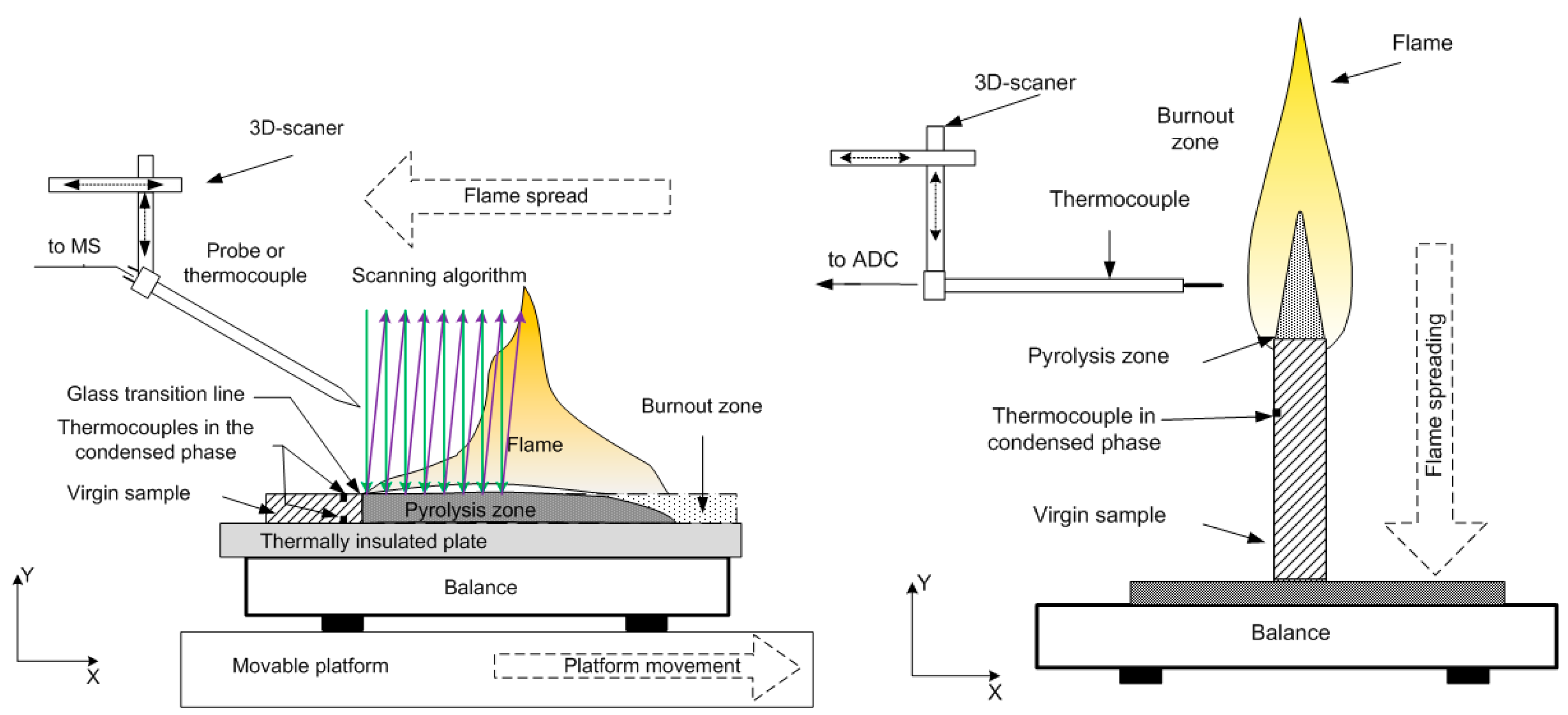
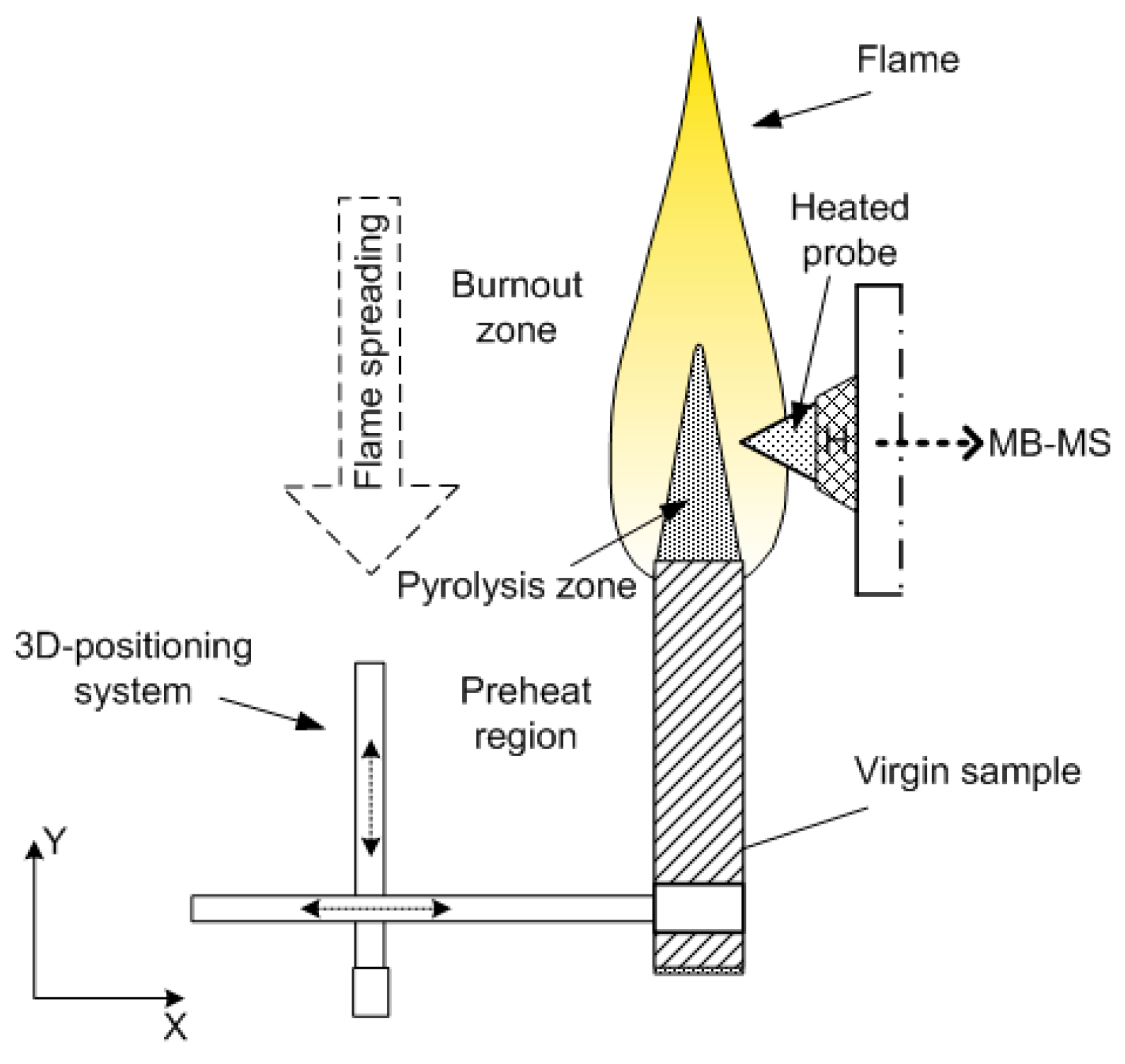



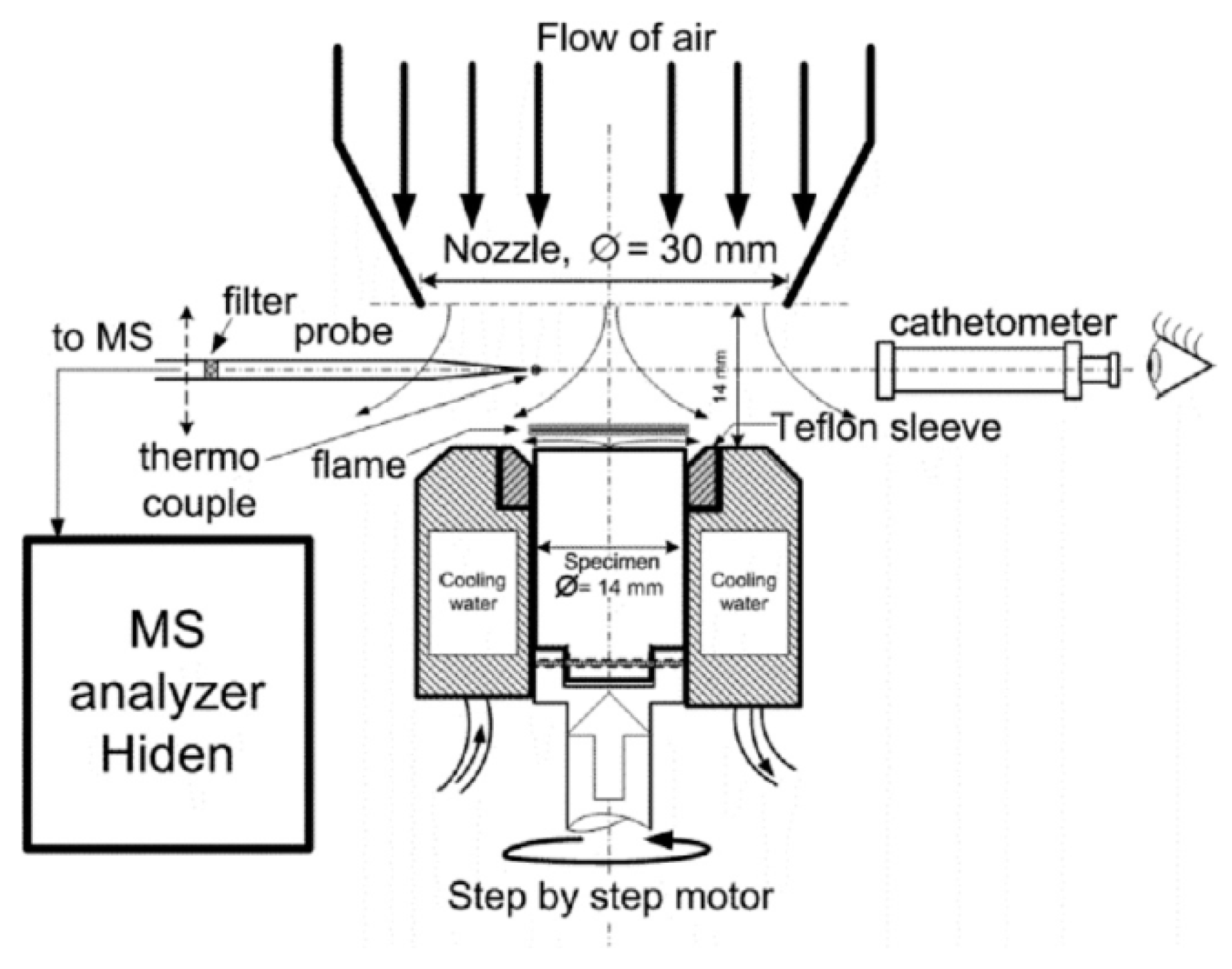

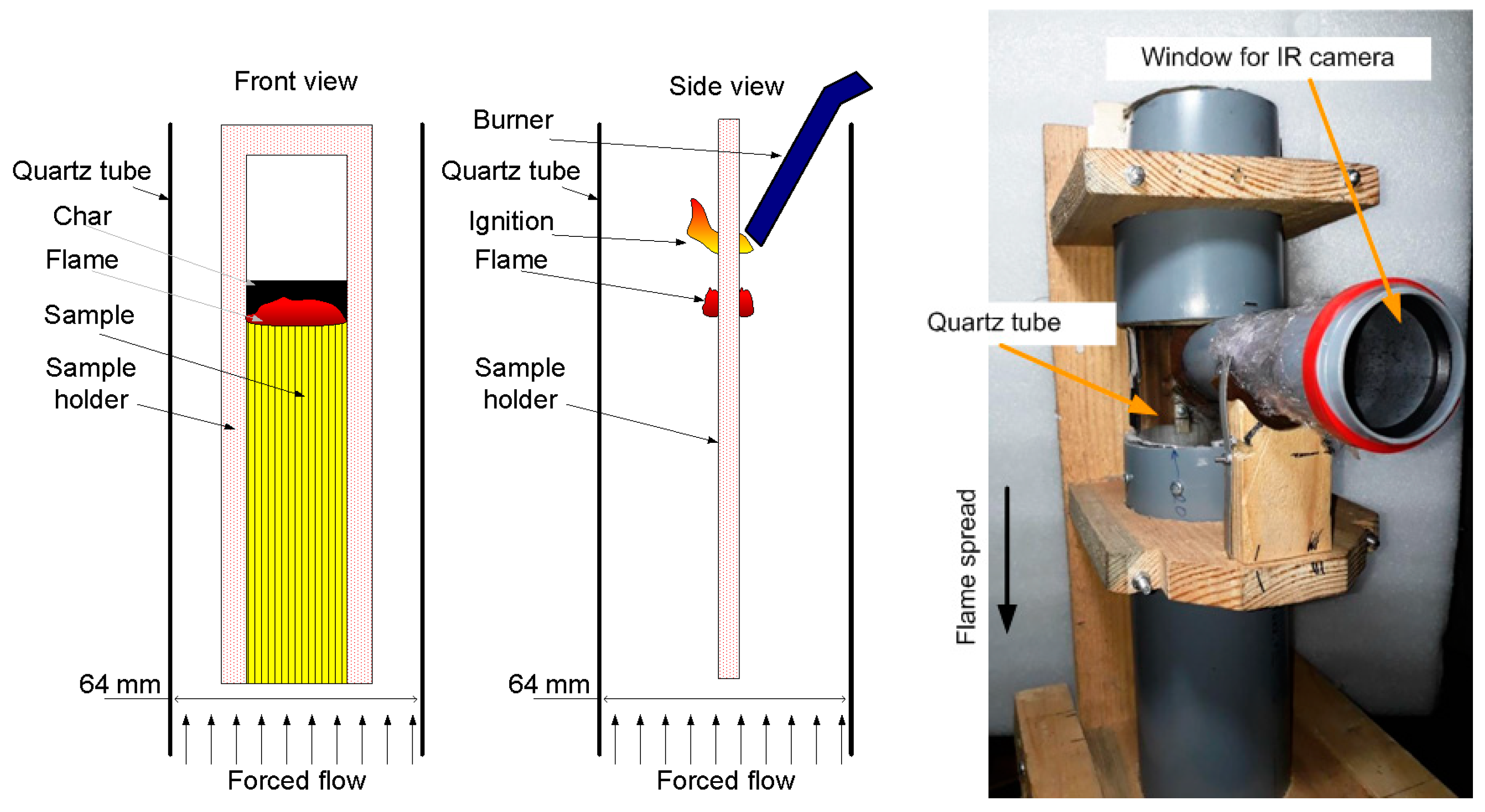
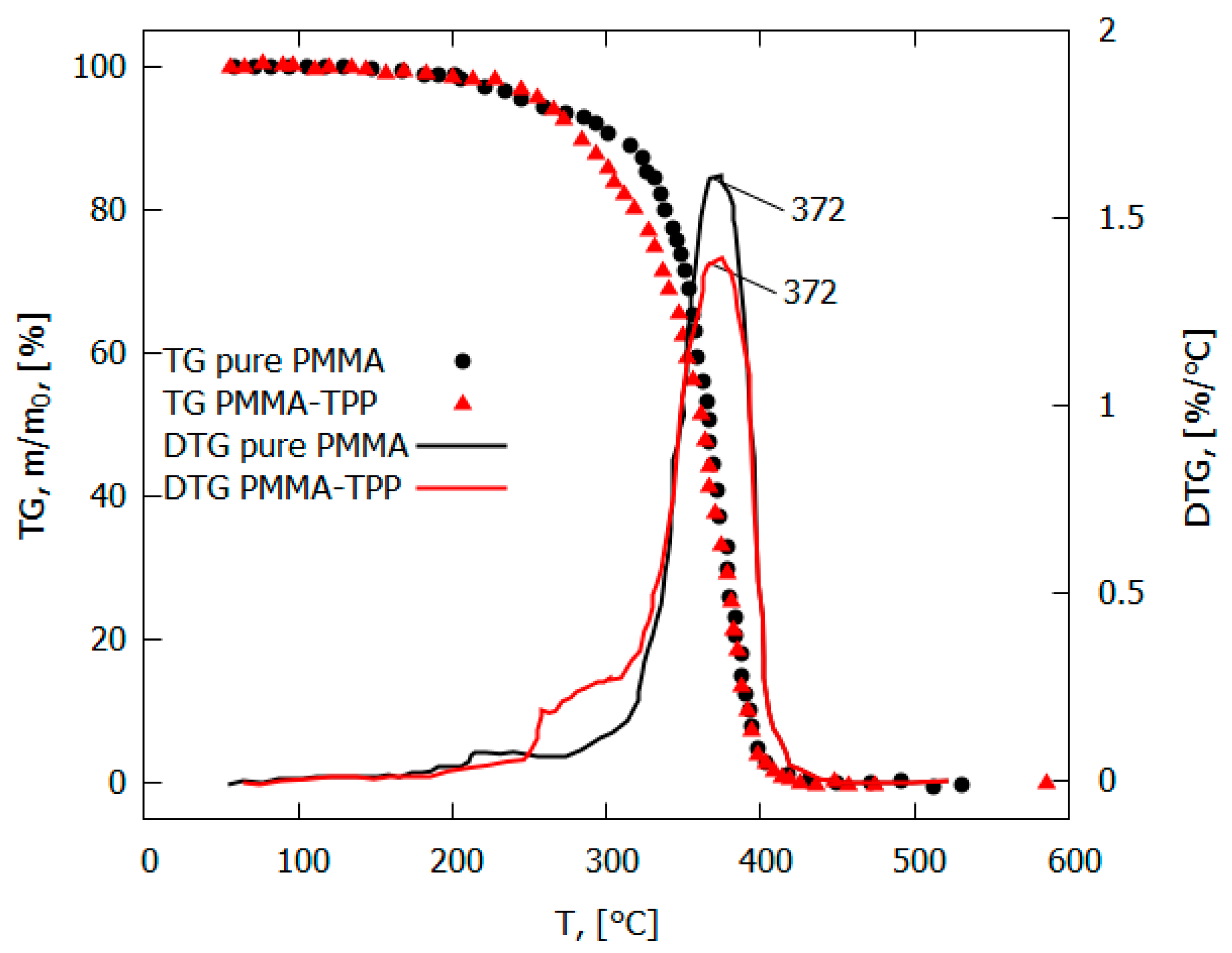
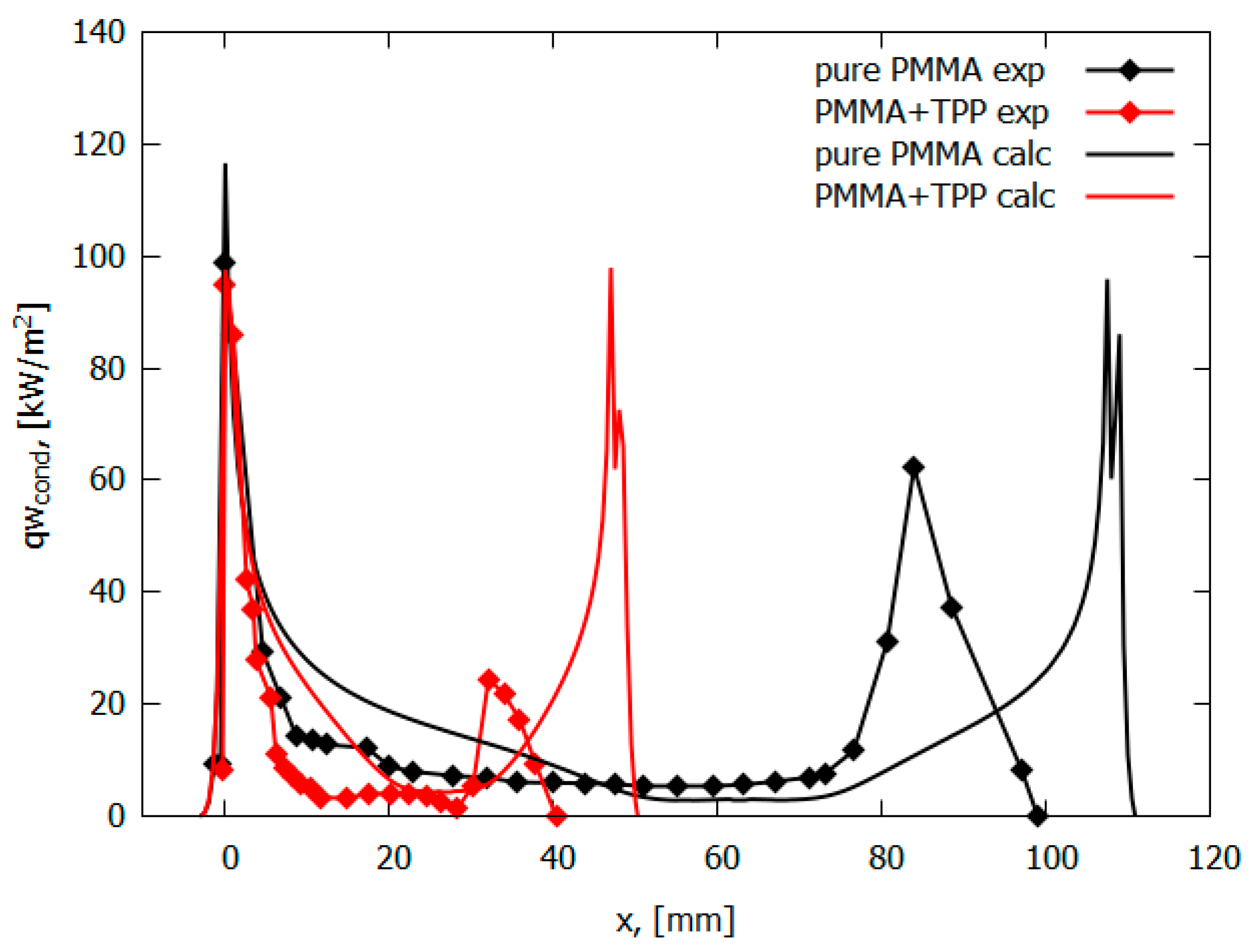

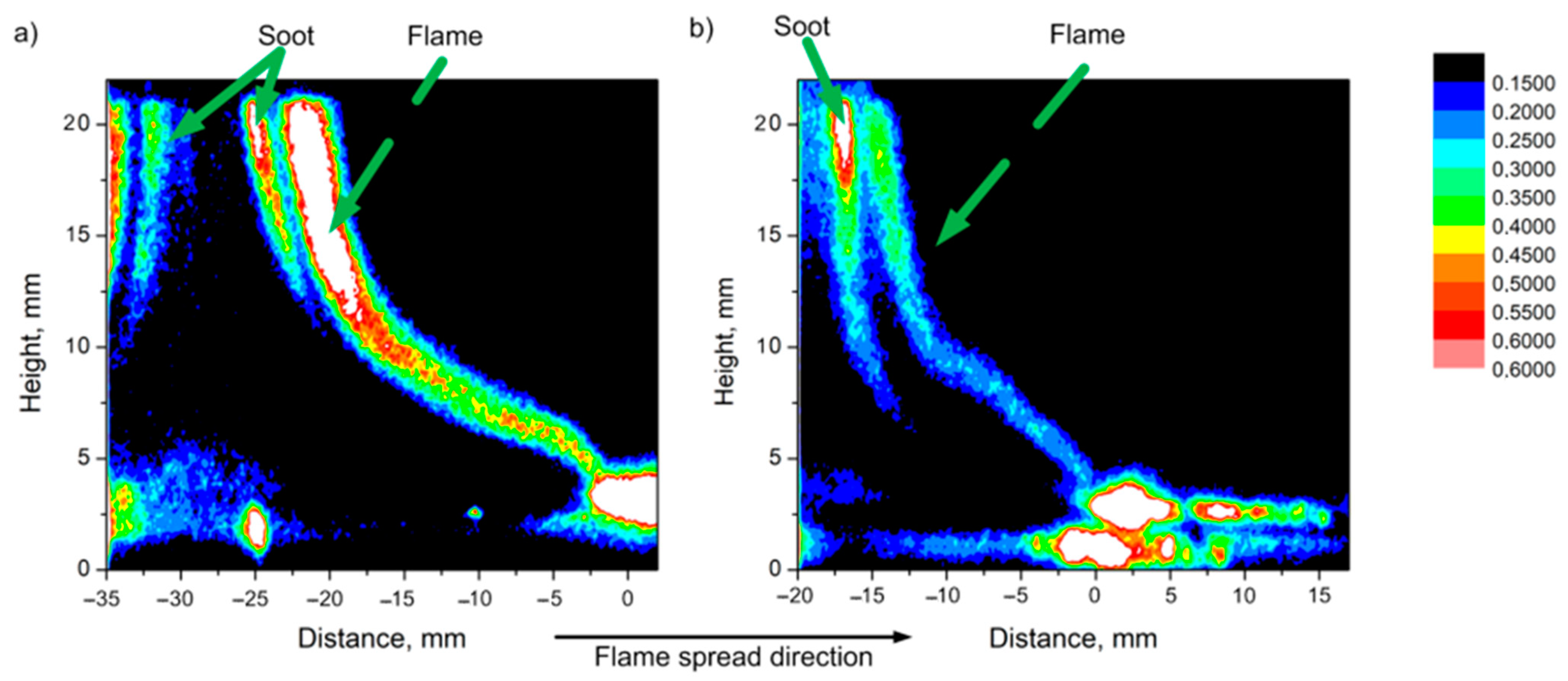
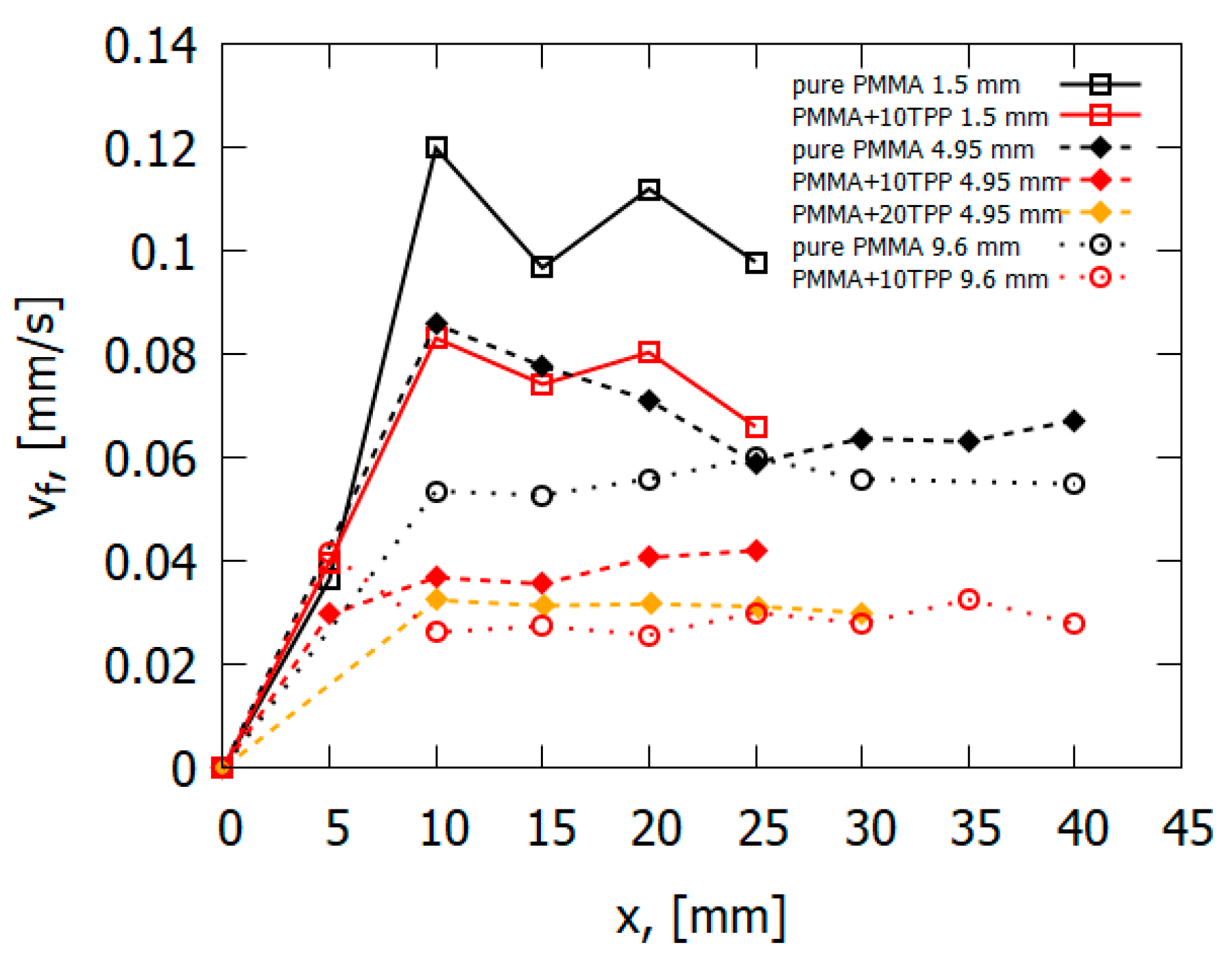


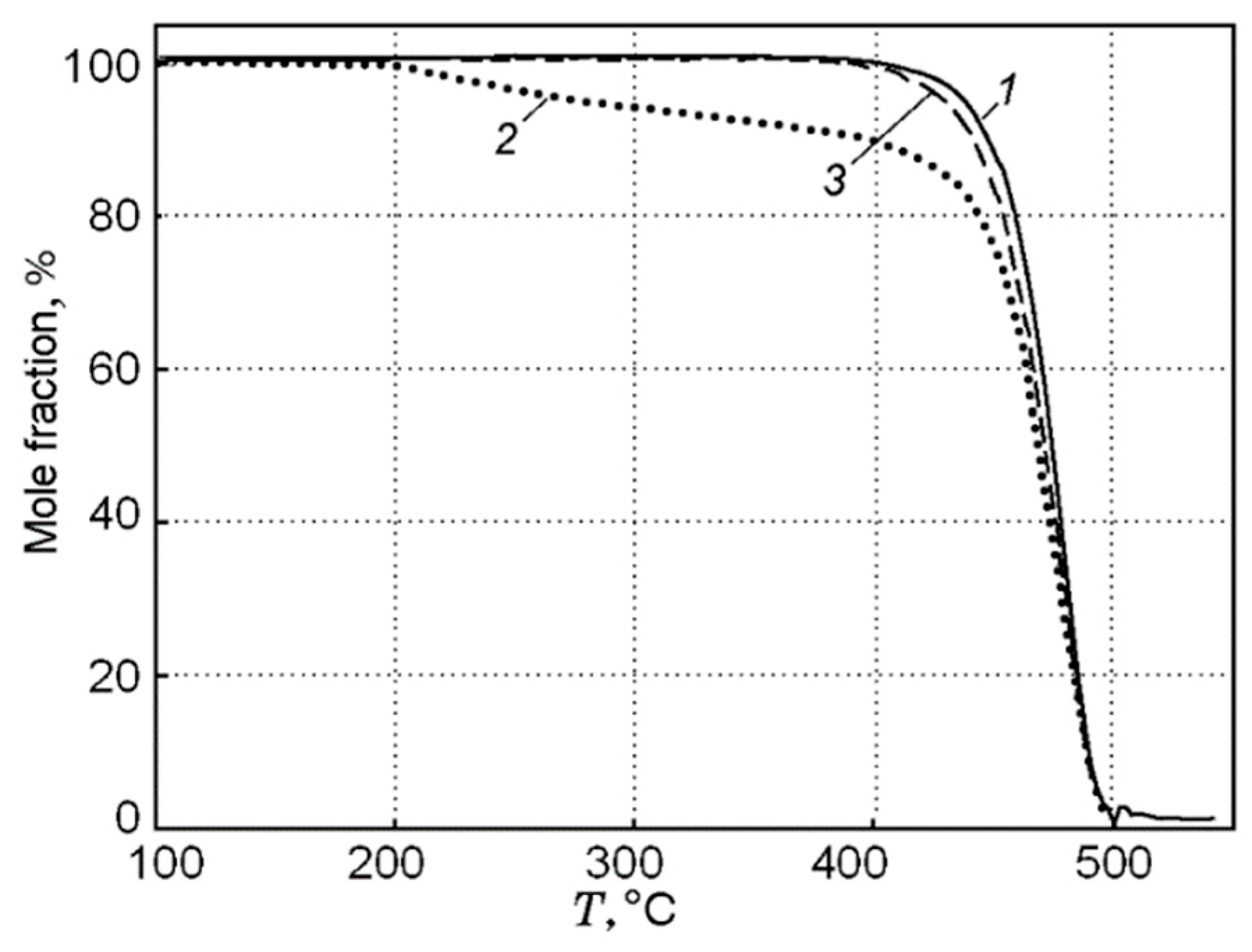

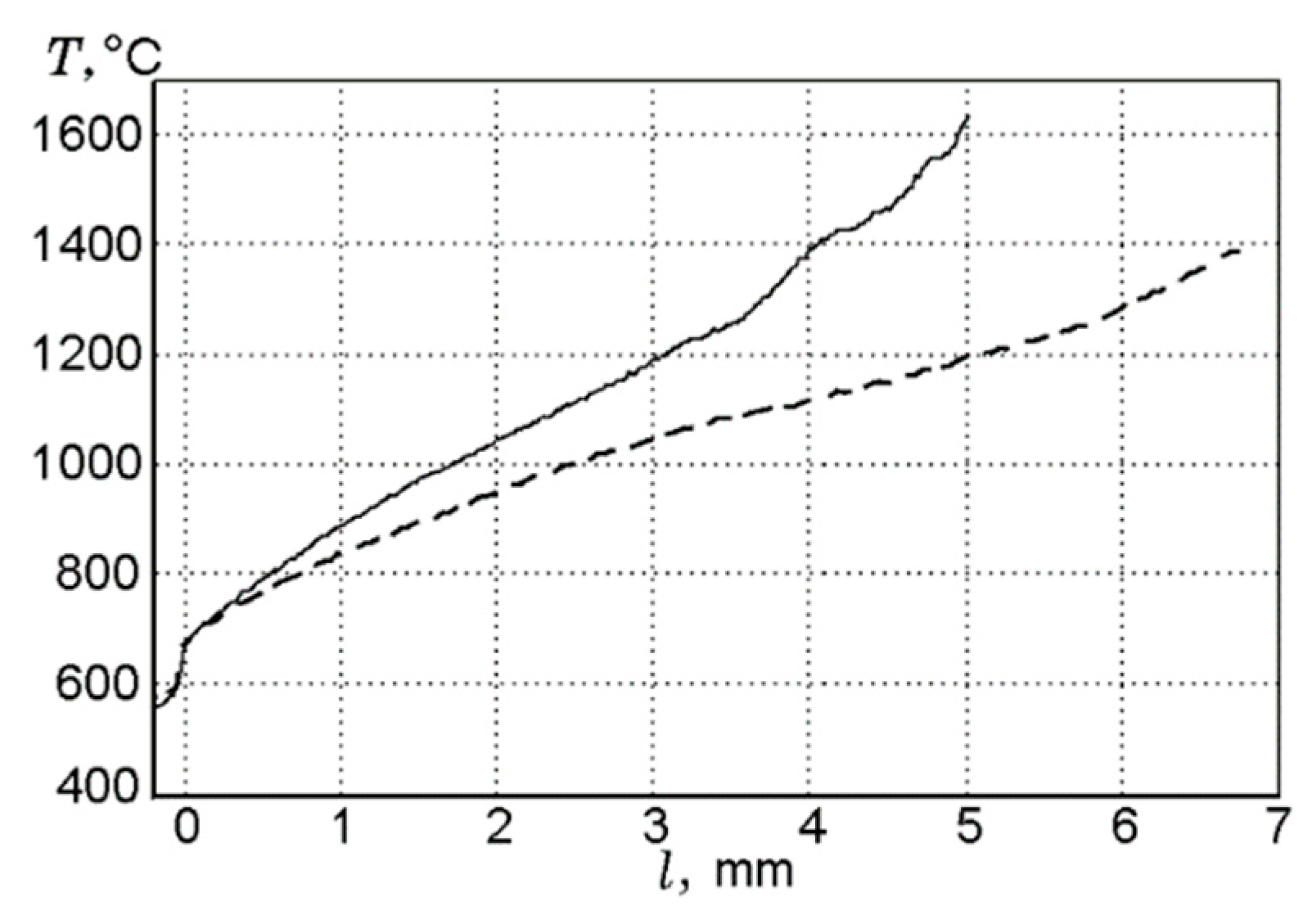
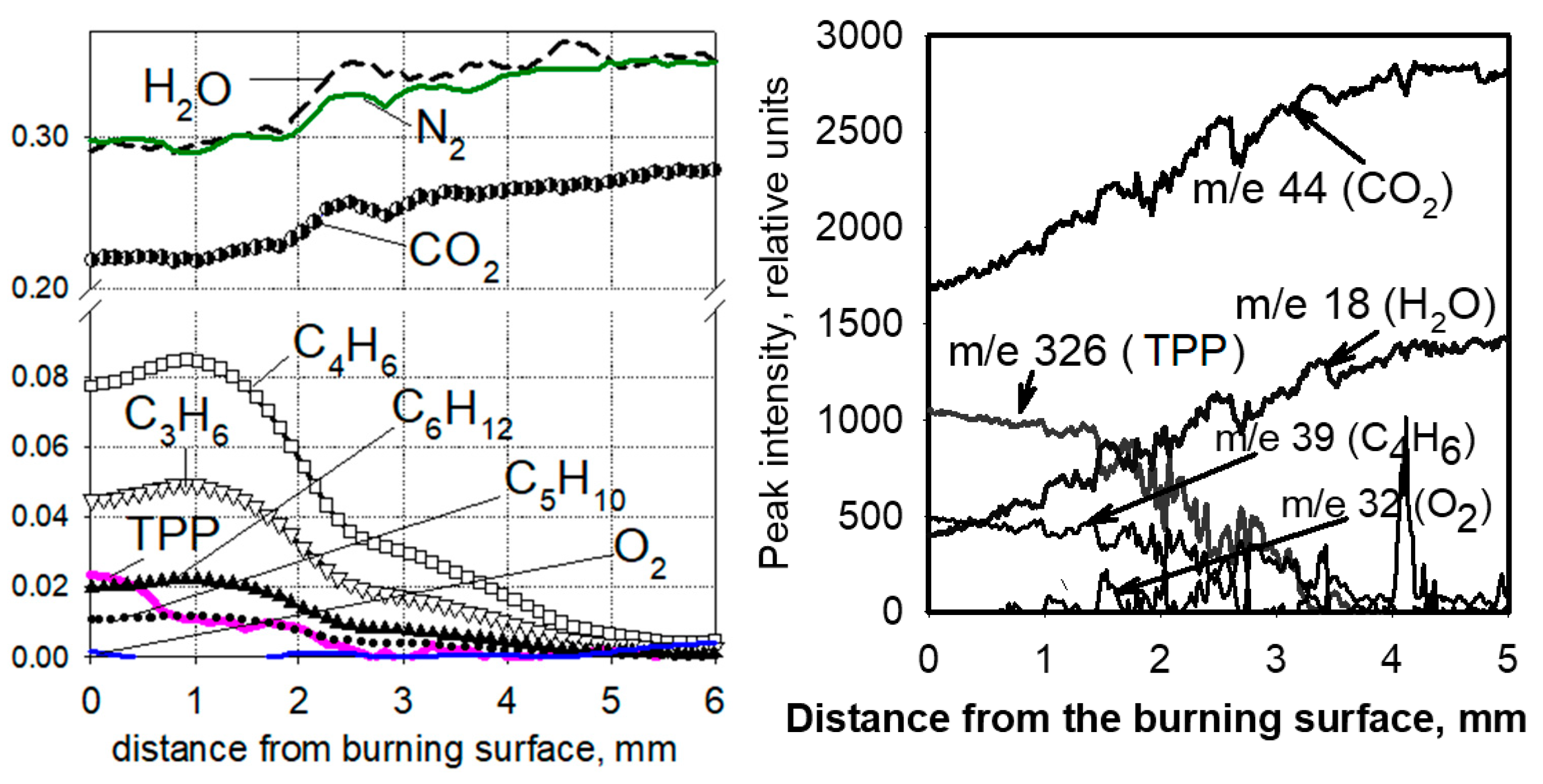
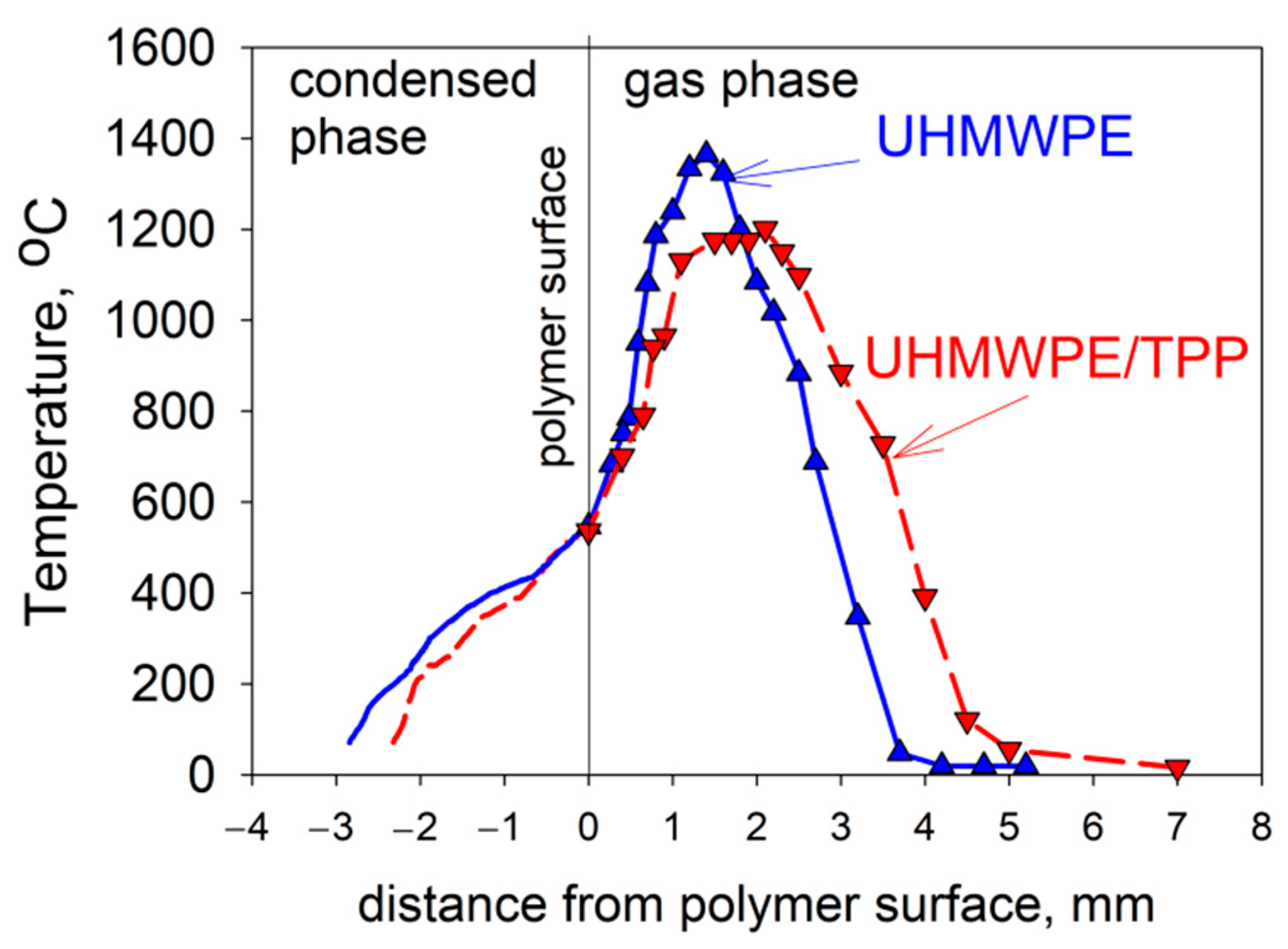
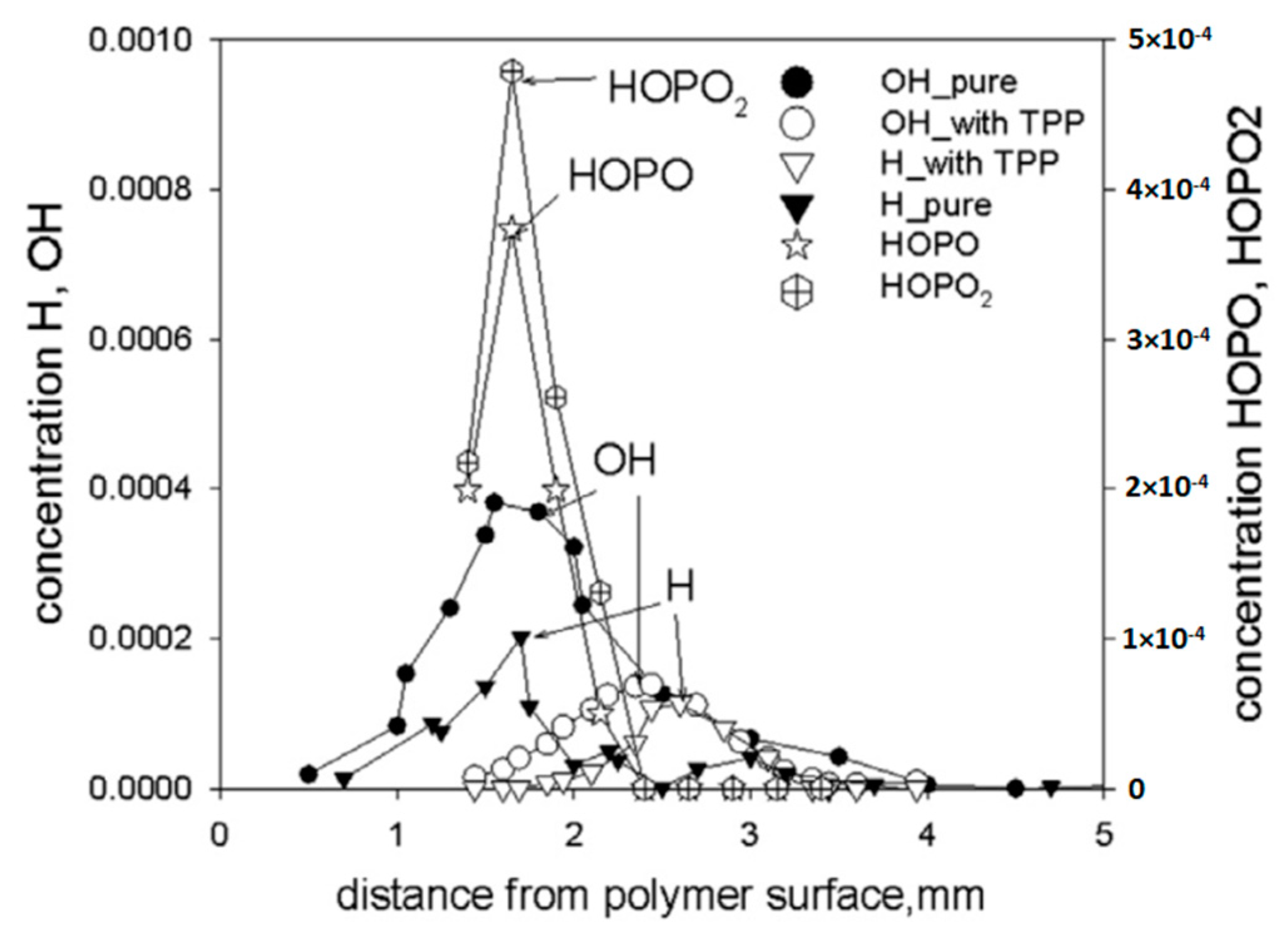
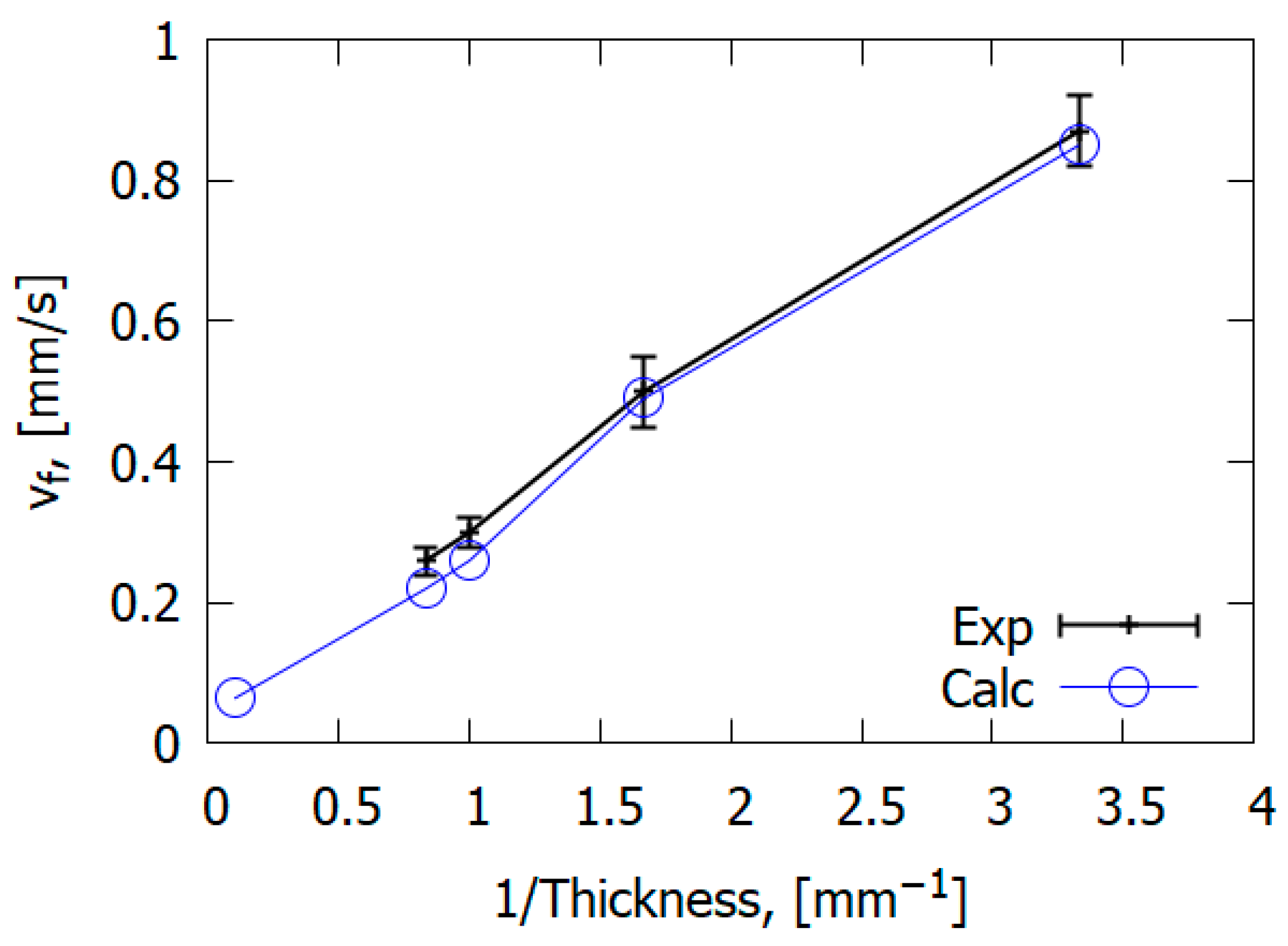
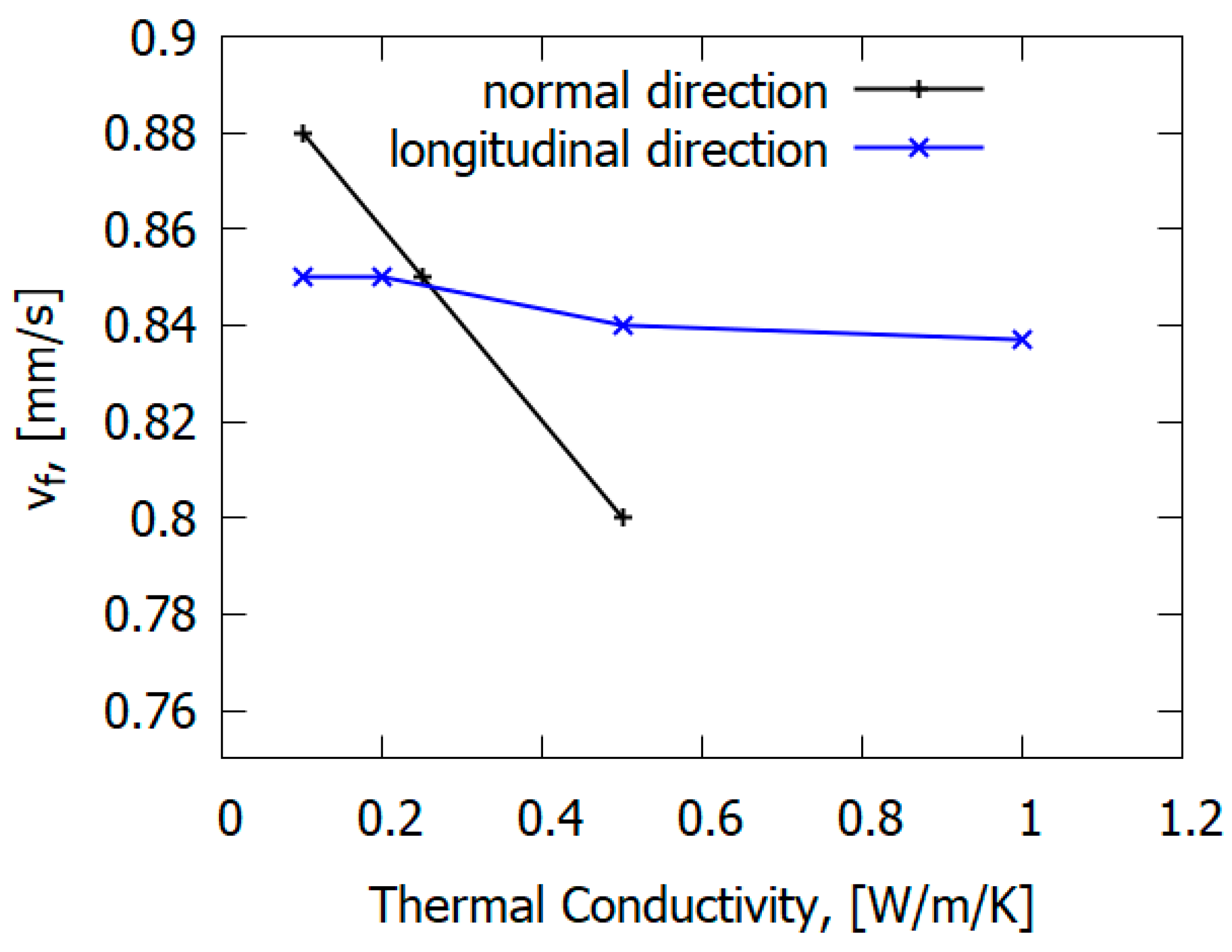
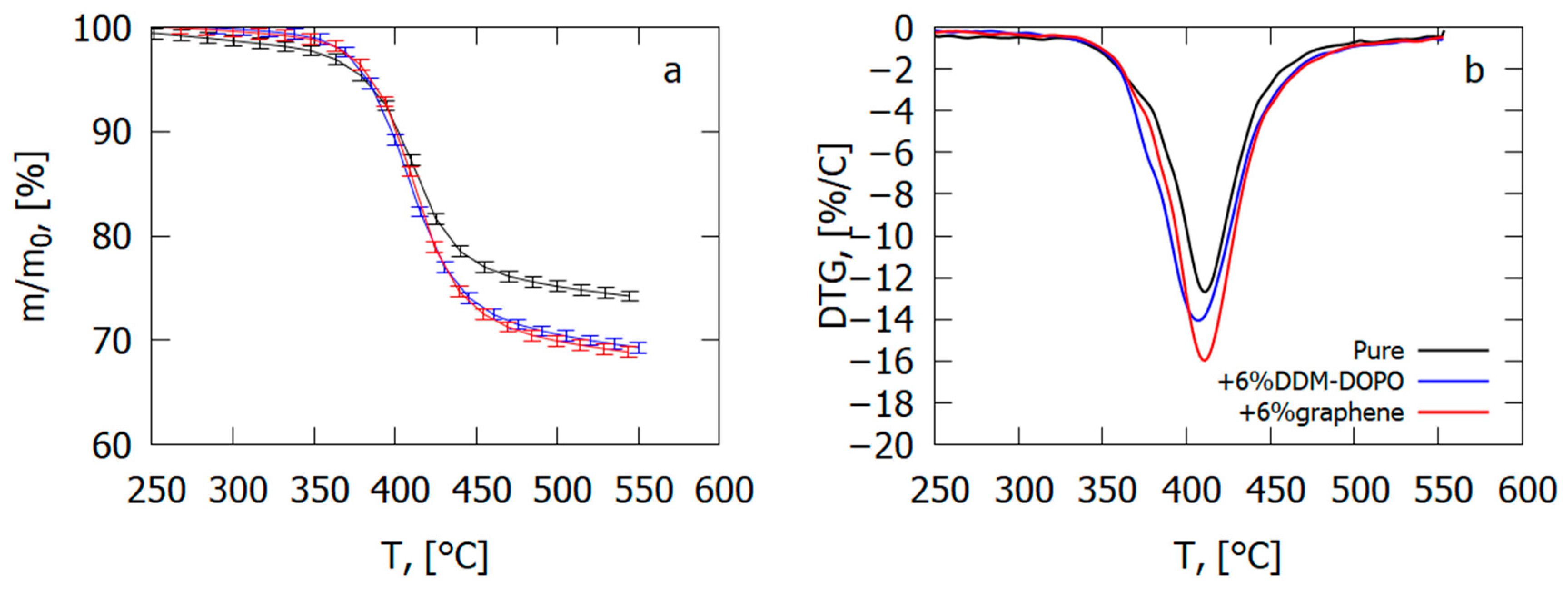

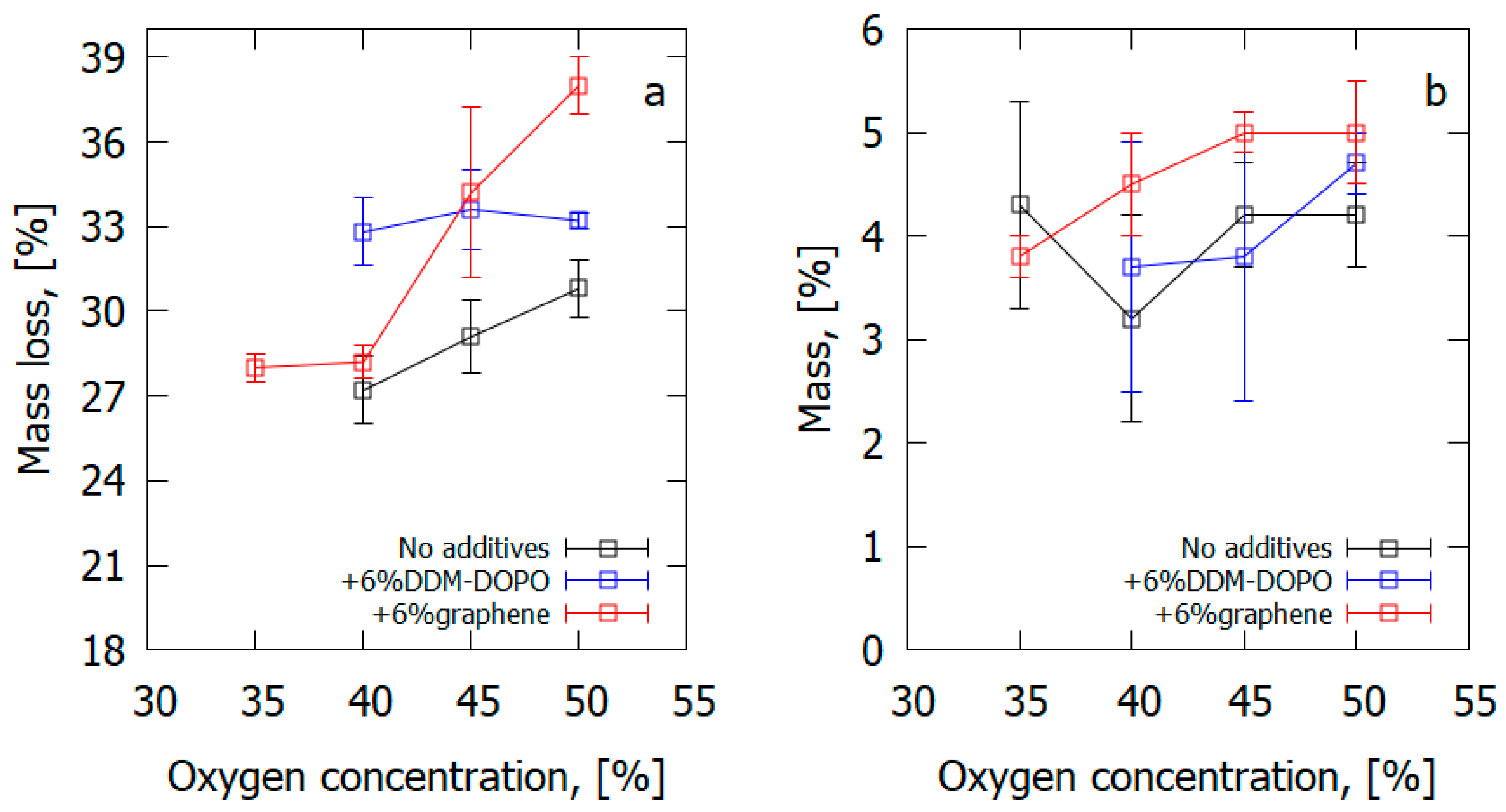
| Sample | TPP, wt% | Thickness, mm | Flame Propagation Direction | ROS, mm/s | Mass Loss Rate, g/s | Pyrolysis Length, Lp, mm | LOI | Ref. |
|---|---|---|---|---|---|---|---|---|
| PMMA | 0 | 1.5 | downward | 0.11 | 0.017 | 3 | - | [50] |
| PMMA + 10%TPP | 10 | 1.5 | downward | 0.073 (−33%) | 0.007 | 1 | - | [50] |
| PMMA | 0 | 4.95 | downward | 0.065 | 0.022 | 9 | 17 | [50] |
| PMMA + 10% TPP | 10 | 4.95 | downward | 0.04 (−38%) | 0.01 | 4 | - | [50] |
| PMMA + 20% TPP | 20 | 4.95 | downward | 0.03 (−54%) | 0.01 | 5 | - | [50] |
| PMMA | 0 | 9.6 | downward | 0.055 | 0.062 | 18 | - | [50] |
| PMMA + 10% TPP | 10 | 9.6 | downward | 0.03 (−45%) | 0.018 | 9 | - | [50] |
| PMMA | 0 | 5 | horizontal | 0.12 | 0.078 | 90 | 17 | [49] |
| PMMA + 10% TPP | 10 | 5 | horizontal | 0.075 (−37%) | 0.054 | 35 | 21 | [49] |
| ROS, mm/s | , 1/s | , kJ/mole | kg (1 − γYTPP), 1/s | Eg, kJ/mole | |
|---|---|---|---|---|---|
| PMMA | 0.12 | 6.45 × 107 | 121.9 | 6 × 109 | 90 |
| PMMA + 10%TPP | 0.075 | 2.29 × 1010 | 153.6 | 1.2 × 108 | 90 |
| Sample | Molecular Weight of the Polymer | Fraction of Flame-Retardant, % | Direction of Flame Propagation | ROS, mm/s | ESR, 1/s | LOI | Peak Conc. H/OH, Mole Fraction | Pyrolysis Kinetics at a Heating Rate of 150 K/s in Ar, log (k0, (1/s)); Ea, kJ/mole, Reaction Order | Maximum Flame Temperature, °C | Ref |
|---|---|---|---|---|---|---|---|---|---|---|
| UHMWPE | 2.5 × 106 | 0 | counterflow | 0.018 | 140 | 2 × 10−4/ 4 × 10−4 | 1380 | [61,62] | ||
| UHMWPE + 5%TPP | 2.5 × 106 | 5 | counterflow | 0.0077 (−57%) | 100 (−28%) | 10−4/ 1.3 × 10−4 (−50%/ −68%) | 1230 | [61,62] | ||
| UHMWPE | 5 × 106 | 0 | “candle” | 0.1(0.25) | 16.8; 249 2 | [69,70] | ||||
| UHMWPE + 5% TPP | 5 × 106 | 5 | “candle” | 0.04(0.11) (−60%) | [70] | |||||
| UHMWPE + 10% TPP | 5 × 106 | 10 | “candle” | 20.5; 340; 2 | [69,70] | |||||
| UHMWPE | 5 × 106 | 0 | “candle” | 0.18 | 16.4 | 8.6; 139; 1 | [60,72,73] | |||
| UHMWPE + 10% TPP | 5 × 106 | 10 | “candle” | 0.09 (−50%) | 19.7 (+20%) | 15.5; 261; 1 | [60,72,73] | |||
| HDPE | 3.8 × 105 | 0 | “candle” | 0.22 | 17.6 | 7.9; 139; 1 | [71,72] | |||
| HDPE + 10% TPP | 3.8 × 105 | 10 | “candle” | 0.04 (−80%) | 19.9 (+13%) | 16; 270; 1 | [71,72] | |||
| HDPE | 105 | 0 | “candle” | 0.3 | 17.5 | 10.1; 172; 1 | [71,72] | |||
| HDPE + 10% TPP | 105 | 10 | “candle” | 0.03 (−90%) | 20.1 (+15%) | 32.4; 561; 1 | [71,72] |
| Sample | LOI, % | UL-94 HB, mm/min | (VBB), g/s | Mass Loss (VBB), g | Tmax DTG 2, °C |
|---|---|---|---|---|---|
| GFRER | 22.4 | 44.5, burned-out 1 | 0.015 ± 0.002 | 0.51 ± 0.11 | 412 |
| GFRER + 6% graphene | 23.9 | 38.3, burned-out 1 | 0.010 ± 0.002 | 0.93 ± 0.18 | 411 |
| GFRER + 6% DDM-DOPO | 26.5 | 34.9, self-extinguished 1 | 0.010 ± 0.002 | 0.66 ± 0.14 | 407 |
| Sample | ks, 1/s | Es, kJ/mole | n | kg, 1/s | Eg, kJ/mole | ψDOPO | (1 − YF,s), Non-Combustible Part |
|---|---|---|---|---|---|---|---|
| GFRER | 6.97 × 1010 | 166 | 1 | 1010 | 90 | 0 | 0 |
| GFRER + 6% graphene | 1.4 × 1019 | 267 | 3 | 107 | 90 | 0 | 0.3 |
| GFRER + 6% DDM-DOPO | 6.97 × 1010 | 166 | 1 | 1010 | 90 | 16.65 | 0 |
| Oxygen Concentration | GFRER, Exp | GFRER + 6% Graphene, Exp | GFRER + 6% DDM-DOPO, Exp | GFRER, Model | GFRER + 6% Graphene, Model | GFRER + 6% DDM-DOPO, Model |
|---|---|---|---|---|---|---|
| 30% | 0.53 | 0.43 | Not burned | 0.6 | 0.42 | 0 |
| 32.5% | 0.61 | 0.48 | Not burned | 0.65 | 0.46 | 0 |
| 35% | 0.62 | 0.5 | Not burned | 0.7 (529 °C) | 0.5 | 0 |
| 37.5% | 0.68 | 0.55 | 0.63 | 0.75 | 0.54 | 0.36 |
| 40% | 0.83 (~500 °C) | 0.6 (~500 °C) | 0.65 (~550 °C) | 0.79 (544 °C) | 0.58 (509 °C) | 0.47 (549 °C) |
| 45% | 1 (~500 °C) | 0.75 (~500 °C) | 0.74 (~550 °C) | 1 (557 °C) | 0.66 | 0.69 |
| 50% | 1.1 (~500 °C) | 0.9 (~500 °C) | 0.88 (~550 °C) | 1.18 (549 °C) | 0.81 (529 °C) | 0.81 (556 °C) |
Publisher’s Note: MDPI stays neutral with regard to jurisdictional claims in published maps and institutional affiliations. |
© 2022 by the authors. Licensee MDPI, Basel, Switzerland. This article is an open access article distributed under the terms and conditions of the Creative Commons Attribution (CC BY) license (https://creativecommons.org/licenses/by/4.0/).
Share and Cite
Korobeinichev, O.; Shmakov, A.; Paletsky, A.; Trubachev, S.; Shaklein, A.; Karpov, A.; Sosnin, E.; Kostritsa, S.; Kumar, A.; Shvartsberg, V. Mechanisms of the Action of Fire-Retardants on Reducing the Flammability of Certain Classes of Polymers and Glass-Reinforced Plastics Based on the Study of Their Combustion. Polymers 2022, 14, 4523. https://doi.org/10.3390/polym14214523
Korobeinichev O, Shmakov A, Paletsky A, Trubachev S, Shaklein A, Karpov A, Sosnin E, Kostritsa S, Kumar A, Shvartsberg V. Mechanisms of the Action of Fire-Retardants on Reducing the Flammability of Certain Classes of Polymers and Glass-Reinforced Plastics Based on the Study of Their Combustion. Polymers. 2022; 14(21):4523. https://doi.org/10.3390/polym14214523
Chicago/Turabian StyleKorobeinichev, Oleg, Andrey Shmakov, Alexander Paletsky, Stanislav Trubachev, Artem Shaklein, Alexander Karpov, Egor Sosnin, Sergey Kostritsa, Amit Kumar, and Vladimir Shvartsberg. 2022. "Mechanisms of the Action of Fire-Retardants on Reducing the Flammability of Certain Classes of Polymers and Glass-Reinforced Plastics Based on the Study of Their Combustion" Polymers 14, no. 21: 4523. https://doi.org/10.3390/polym14214523
APA StyleKorobeinichev, O., Shmakov, A., Paletsky, A., Trubachev, S., Shaklein, A., Karpov, A., Sosnin, E., Kostritsa, S., Kumar, A., & Shvartsberg, V. (2022). Mechanisms of the Action of Fire-Retardants on Reducing the Flammability of Certain Classes of Polymers and Glass-Reinforced Plastics Based on the Study of Their Combustion. Polymers, 14(21), 4523. https://doi.org/10.3390/polym14214523






